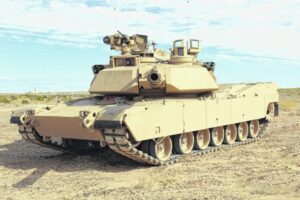Real Wheels: A miracle on Buckeye Road
 When a group of workers at the Lima Army Tank Plant heard about reports of roadside bombs ripping holes in the bottom of Abrams tanks during the Iraq War, they began to brainstorm ideas for making the tanks safer. Using a napkin in the lunchroom, they drew up a solution. One week later new armor was on its way to the battlefield.
When a group of workers at the Lima Army Tank Plant heard about reports of roadside bombs ripping holes in the bottom of Abrams tanks during the Iraq War, they began to brainstorm ideas for making the tanks safer. Using a napkin in the lunchroom, they drew up a solution. One week later new armor was on its way to the battlefield.
The Lima News
LIMA — Twenty years ago this April, one of the greatest moments in the history of the Abrams tank took place in a lunch room at the Lima Army Tank Plant.
It’s a story about saving the lives of American soldiers. A tale of making sure those who served this country overseas returned home with two arms, two hands and 10 fingers to grab and hug their wives and mothers; and two legs, two feet and 10 toes to play ball with their sons and daughters. Most of all, it is a story about heroes.
These heroes worked at the Lima Army Tank Plant during the Iraq war. They were perplexed by reports of roadside bombs blowing holes into Abrams tanks, killing or maiming the soldiers inside. During a lunch break, a group of the workers began brainstorming ideas on how to make the tanks safer. The workers used a napkin to draw their ideas for a new armored plate. In only seven days, engineers and production workers had put their solution into use. On April 12, 2003, new armor for the M1A2 tank was headed from Buckeye Road in Shawnee Township to a battlefield halfway around the world.
Lt. Col. Damon Walsh, who was the tank plant commander at that time, said what workers had accomplished amounted to a miracle in manufacturing.
“There’s nothing that’s gone from napkin to production in seven days,” Walsh lamented. “It’s incredible.”
Walsh said welders and cutters worked around the clock to produce 20 armor kits ready for shipping.
The new armor consisted of armor-plated steel louvers, which were fitted over the exhaust and intake vents of the M1A2’s engine in the rear of the tank. The louvers were used to allow exhaust and air to flow as needed, but were designed to deflect enemy missiles and grenades, he said.
While workers in Lima began cutting and assembling the armor kits, crews in Aberdeen, Md., began testing the prototypes by firing rockets at them, then-plant manager Keith Deters pointed out.
“As we started building, they started proving them at Aberdeen proving grounds,” Deters said.
Deters would later refer to everything that happened during that week in April as the “the napkin story.” He said it spoke volumes about the power of teamwork.
Walsh agreed.
“Guys in the desert are going to be that much safer because of what they do here in the tank plant,” Walsh said.